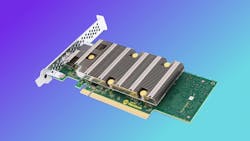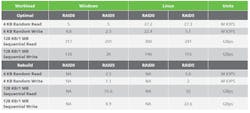Storage Accelerator Speeds Up NVMe Arrays
Flash-memory Non-Volatile Memory Express (NVMe) storage devices are very reliable. However, without redundant array of inexpensive disks (RAID) support, they’re a single point of failure in a multiple-drive system. This is why RAID systems are typically employed when reliability is important, such as in the data center.
RAID 1 uses two drives that mirror each other. The loss of one enables the system to continue operating. RAID 0 is a configuration with no redundancy, but it provides the maximum disk space of an array.
The overhead in a RAID 1 system is 50%, which is why other RAID configurations like RAID 5 and 6 will be used when more drives are involved. Unlike RAID 1, where the data is the same on both drives, these other RAID configurations employ a parity-like scheme that allows data to be retained even when one or more drives fail (depending on the RAID configuration).
>>Check out more of our Future of Storage and Memory Conference 2025 coverage
With this approach, a RAID array can be rebuilt when a failed drive is replaced while the array continues to operate. XOR operations calculate the data to be written to the drives, as well as in the recovery operation.
A Different Controller Approach
Software RAID support is possible, but it puts the calculation burden on the host. This is where RAID storage accelerators like Microchip’s SmartRAID 4300 come into play (see figure).
The configuration differs from the RAID controller approach, where the drives are hidden behind the controller. In the storage accelerator method, the controller works in tandem with the host, which has direct access to the NVMe drives in the array along with the storage accelerator.
The storage accelerator setup is a combination of hardware and software, with the software drivers taking advantage of the storage accelerator computational support. Microchip’s accelerators support RAID 5 (see table). A typical configuration includes up to 32 x4 NVMe drives in an array with up to 64 logical arrays. It supports PCIe Gen 4 and Gen 5.
The storage accelerator supports self-encrypting drives (SEDs). Its trusted platform supports hardware root of trust that is aligned with the Open Compute Project (OCP). Software is provided by Adaptec’s MaxView, which includes a web-based interface. Out-of-band Baseboard Management Controller (BMC) management includes the Distributed Management Task Force (DMTF) standards-based management, Platform-Level Data Model (PLDM), and Redfish Device Enablement (RDE) via MCTP protocol.
>>Check out more of our Future of Storage and Memory Conference 2025 coverage
About the Author
William G. Wong
Senior Content Director - Electronic Design and Microwaves & RF
I am Editor of Electronic Design focusing on embedded, software, and systems. As Senior Content Director, I also manage Microwaves & RF and I work with a great team of editors to provide engineers, programmers, developers and technical managers with interesting and useful articles and videos on a regular basis. Check out our free newsletters to see the latest content.
You can send press releases for new products for possible coverage on the website. I am also interested in receiving contributed articles for publishing on our website. Use our template and send to me along with a signed release form.
Check out my blog, AltEmbedded on Electronic Design, as well as his latest articles on this site that are listed below.
You can visit my social media via these links:
- AltEmbedded on Electronic Design
- Bill Wong on Facebook
- @AltEmbedded on Twitter
- Bill Wong on LinkedIn
I earned a Bachelor of Electrical Engineering at the Georgia Institute of Technology and a Masters in Computer Science from Rutgers University. I still do a bit of programming using everything from C and C++ to Rust and Ada/SPARK. I do a bit of PHP programming for Drupal websites. I have posted a few Drupal modules.
I still get a hand on software and electronic hardware. Some of this can be found on our Kit Close-Up video series. You can also see me on many of our TechXchange Talk videos. I am interested in a range of projects from robotics to artificial intelligence.




